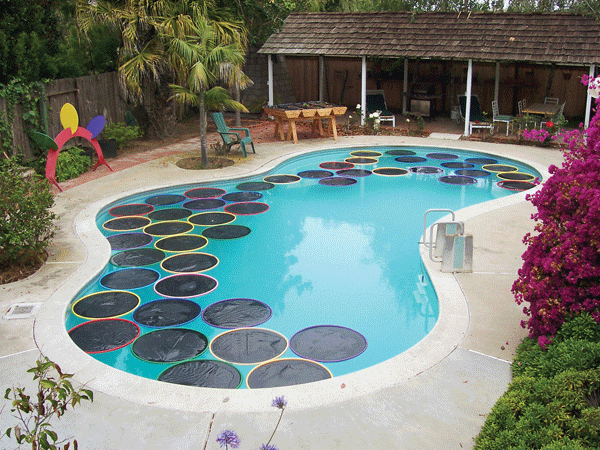
With temperatures on the rise and the first day of summer only 3 weeks away, pool season is just about upon us. Back in MAKE Volume 23, rocket engineer Edward Hujsak shared an efficient, low-cost, safe, and easy way to warm your pool. His project is the Lily Pad pool warmers, and they’re essentially made of hula hoops covered with black polyethylene film. The how-to is freely available for you on Make: Projects, where community member Daniel Busby commented, sharing the video he made of his Lily Pad build. The only difference between Edward’s instructions and Daniel’s build is that Edward used a soldering iron to spot weld the plastic to the hoops, and Daniel chose to use a household iron. Here’s Daniel’s video:

In his article, Edward also included an interesting sidebar titled “The Pool Owner’s Dilemma”:
The thermal behavior of swimming pools is complex, due to a number of factors that act to cool the water, while the sun and artificial means work to keep the water warm. Cooling forces are at work day and night, and include evaporation, conduction into surrounding soil, air current effects, and nighttime longwave (infrared) radiation into space.
Gas-fired heaters are the most common pool warmers, but up-front costs for equipment and installation run into the thousands of dollars. And then there’s the operating cost and the price of natural gas. These heaters are prodigious polluters; for an average-sized pool, a 1°F rise in temperature results in spewing 50lbs to 60lbs of carbon dioxide into the atmosphere.
Roof-mounted solar heaters are a second option. Water from the pool is pumped through solar-heated heat exchangers and returned to the pool. Like gas-fired heaters, solar heaters are costly and are generally unsightly. They’re also a problem in frost-prone areas.
Bubble plastic blankets are passive devices that cover the pool. They function mainly as water conservation devices by inhibiting evaporation, thus slowing evaporative cooling. They also block nighttime radiation loss. Manufacturers claim these blankets also behave as warmers, transmitting additional energy from the sun into the water. But water already has a very low albedo (ratio of incident energy to reflected energy). It’s about .10 for deep water, a bit higher in white-bottomed pools, and it’s doubtful that bubble covers improve on that. (The low albedo of water is the reason for the great concern about the receding of the polar ice caps. Open water warms much more rapidly than ice fields, which reflect more than 80% of the sun’s energy.) Moreover, pool blankets destroy the aesthetic appeal of a backyard pool; they’re hard to manage, difficult to clean, and unsafe where small children are around; and they’re often dumped after a single season.
ADVERTISEMENT






